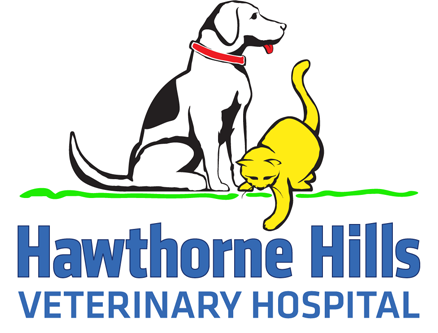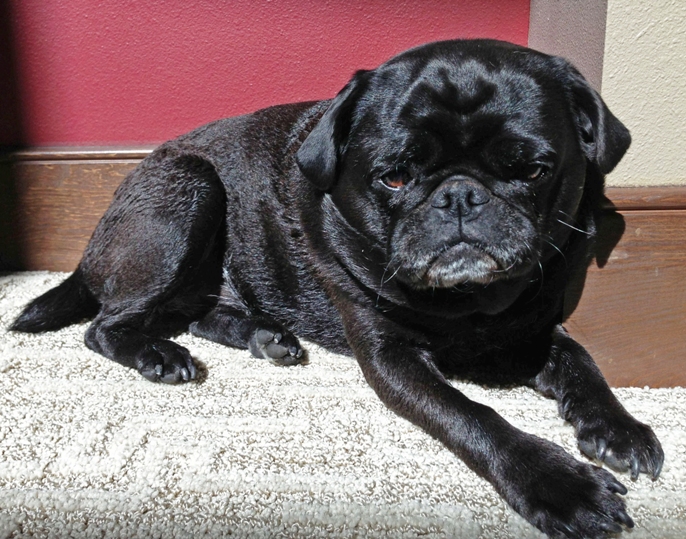
Dental advice from your expert veterinarians in Seattle, WA
Pixie “Putsy” is an energetic six year old pug with a zest for life. As part of her recent health examinations we evaluated Putsy’s teeth. Visually she had a fair amount of tartar buildup especially on the upper teeth. Her owners reported that she wasn’t showing any signs of discomfort, was eating normally and playing with her toys and the three other dogs at home in Seattle. Putsy is typical of many of our patients.
For a variety of reasons, dogs and cats do not complain about infected teeth the way you and I would; most likely because:
- What is their alternative?
- They want to eat, they want to play ball and chew on toys;
- They don’t know that their mouth should be pain free; they can’t tell us with words how they feel; and
- They have powerful instincts that drive the “don’t show your enemy your weakness or you might be someone else’s meal”.
The doctors and staff at Hawthorne Hills Veterinary Hospital are devoted to helping dogs and cats maintain their healthy smiles. As pet owners, if our goal is to give our pet a happy, comfortable life, we need to commit to appropriate and regular care of their teeth and mouth. While home care is the most important aspect of regular dental care, professional cleanings are necessary on a periodic basis.
Putsy’s dedicated owners were doing what they could at home and yet we can see from the pictures how much tartar had accumulated.
Pugs as a breed have shortened faces (along with other breeds like Boxers, Bulldogs, and Boston Terriers) and as a consequence their teeth are often rotated and crowded together. This makes it easy for food and bacteria to collect around the tooth surface and also to get caught between the teeth. Brushing the teeth regularly helps decrease the amount of tartar buildup, but it won’t remove everything. We know how important regular dental care is for people and the same is true for dogs and cats.
Many times we cannot see the full extent of dental disease just by looking at the tooth and gums. Dental radiographs are an essential part of the treatment planning. During Putsy’s procedure we took a series of x-rays and we discovered that she had a broken upper incisor (the gum had grown over the top of the tooth), multiple abscessed teeth and a tooth buried below the gums.
Under anesthesia, veterinarian Dr. Robin Riedinger gave Putsy additional pain medications, and used a local anesthetic nerve block before extracting the damaged teeth. This ensures that Putsy will be as comfortable as possible when she wakes up and while her mouth is healing. The gums are closed with sutures that will eventually dissolve.
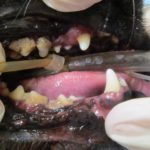 The rotation and crowding of the teeth is evident in this picture taken at the beginning of the dental procedure. There is heavy tartar on the upper rear teeth, and moderate tartar on the lower teeth. The first tooth behind the large lower canine tooth is buried below the gum line and not visible. Because there is dark pigment in the mouth, the inflammation of the gums is easily missed.
The rotation and crowding of the teeth is evident in this picture taken at the beginning of the dental procedure. There is heavy tartar on the upper rear teeth, and moderate tartar on the lower teeth. The first tooth behind the large lower canine tooth is buried below the gum line and not visible. Because there is dark pigment in the mouth, the inflammation of the gums is easily missed.
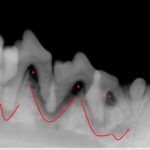 This radiograph shows the infected teeth on the lower right side. The picture also shows the crowding and overlapping of the teeth. Tartar was present all the way down the roots. The red lines show the space where there is bone loss around the tooth roots. The red stars show where there is loss of bone underneath the crown of the tooth. None of that was visible from the outside.
This radiograph shows the infected teeth on the lower right side. The picture also shows the crowding and overlapping of the teeth. Tartar was present all the way down the roots. The red lines show the space where there is bone loss around the tooth roots. The red stars show where there is loss of bone underneath the crown of the tooth. None of that was visible from the outside.
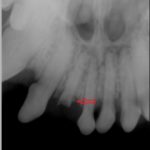 The red arrow in this radiograph points to the broken incisor. This tooth fragment was underneath the gum and not visible from the outside. The broken portion was completely removed during the dental procedure.
The red arrow in this radiograph points to the broken incisor. This tooth fragment was underneath the gum and not visible from the outside. The broken portion was completely removed during the dental procedure.
This photograph shows Putsy’s healthy mouth after extraction of the infected teeth and suturing of the gums. Everything should heal within 10-14 days.
 Hawthorne Hills Veterinary Hospital carries a variety of products, including toothpastes, tasty dental treats, special dental foods, and mouth rinses which can help you and your pet address their specific needs. Our trained staff is always willing to help you find the best solutions and can teach you how to start your pet on a path to a healthy smile.
Hawthorne Hills Veterinary Hospital carries a variety of products, including toothpastes, tasty dental treats, special dental foods, and mouth rinses which can help you and your pet address their specific needs. Our trained staff is always willing to help you find the best solutions and can teach you how to start your pet on a path to a healthy smile.
It is important for every pet owner to know that some people advocate “anesthesia free dentistry” as an alternative to professional dental care under anesthesia. While this sounds attractive, and seems safer, this procedure gives you, the pet owner, a false sense of providing appropriate care because it does not allow for a thorough evaluation and it does not prevent pain during the procedure.
Dental cleaning procedures must be done under anesthesia for the following reasons:
- It is essential that we fully evaluate and treat all of the changes present if we are to do the right thing for the patient.
- With the patient awake it is not possible to do a thorough job. Scraping the visible tartar off of the tooth is not the same as a systematic cleaning and polishing of all surfaces of the teeth.
- When the teeth are crowded or rotated it is much more common to encounter problems; these can be easily overlooked if the patient is awake.
- Anesthesia allows our veterinarians to inspect the insides surfaces of the teeth next to the palate and tongue, and also to probe below the gum line.
- Dental radiographs can only be taken with the patient asleep; without the images, disease below the gums will go undetected and untreated.
- Anesthesia also enables an important part of a complete dental procedure, evaluation of the other tissues in the mouth and throat including the tonsils, the epiglottis, and the underside of the tongue. These are areas easily missed with the patient awake and moving.
- Most importantly, anesthesia also allows us to thoroughly inspect and treat the teeth and gums without causing pain and discomfort to the patient.
Here are a number of sites which provide more information on dental health care for pets:
- Veterinary Dental Specialists, Information for Pet Owners: http://www.avdc.org/ownersinfo.html
- Veterinary Oral Health Council: http://vohc.org/
- What to Expect if Your Pet Needs Dental Care: http://www.veterinarypartner.com/Content.plx?P=A&S=0&C=0&A=168
- Home Dental Care: http://www.veterinarypartner.com/Content.plx?P=A&S=0&C=0&A=640
- Consequences of Anesthesia Free Dentistry: http://www.vetdentists.com/consequences-anesthesia-free-pet-dental-care/
Myths of Anesthesia Free Dentistry: http://wellpets.com/pet-owner-information/anesthesia-free/
